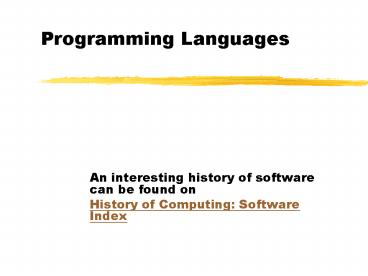Programming Languages PowerPoint PPT Presentation
1 / 23
Title: Programming Languages
1
Programming Languages
- An interesting history of software can be found
on - History of Computing Software Index
2
From Algorithm to Program
- A program is an algorithm
- As seen in the lecture on algorithms, a program
is a very precise algorithm that is written in
primitives - We know that programs have several levels the
lowest being machine code.
3
Generations of Languages
- Machine Language, 1st generation
- Assembler, 2nd generation
- High level languages, 3rd generation
4
1st Generation Programming Language was Machine
code
- Suppose you were given the following list of
instructions to perform - 0001 0011 0011 1011
- 1101 0111 0001 1001
- 1111 0001 1101 1111
- 0000 1100 0101 1101
- 0001 0011 0011 1011
- it is extremely confusing for a computer
programmer
5
2nd Generation Programming language was Assembler
language
- Program from the Virginia Tech Courseware
- LOAD 5
- STORE 15
- EQUAL 15
- JUMP 6
- HALT
- ADD 1
- JUMP 3
6
2nd Generation Programming languages were machine
oriented
- op-codes are given an English mnemonic (memory
aid) - Second thing, not shown in courseware is
symbolic addressing
7
2nd generation programming languages were machine
oriented.
- In order to write a program the programmer had to
have a basic understanding of the machine to use
instructions such as load, store, etc. - Must understand that math can only be done in the
ALU
8
The 3rd Generation programming languages started
with FORTRAN
- FORTRAN was invented in the early 1950s and was a
scientific language - FORTRAN Stood for FORmula TRANslation
- Developed by a team headed by John Backus
- In the 1950s most computers were used for
scientific purpose since they were too expensive
for businesses
9
Example of a FORTRAN program
- Remember our Assembler language program
- LOAD 2
- STORE 13
- LOAD 5
- STORE 14
- LOAD 13
- ADD 14
- STORE 15
- HALT
10
In FORTRAN this program would be
- x 2
- y 5
- Z x y
- Note that the programmer does not have to know
about load and store operations etc.
11
First business language was COBOL Common Business
Oriented Language
- Was developed by the US Department of Defense and
first version was around 1960 - Rear Admiral Dr. Grace Murray Hopper was the
project leader - Why did the military need a business language?
12
COBOL Why the military?
- Who has one the biggest payrolls to pay?
- Who purchases millions of of equipment?
- Who has one of the biggest inventories?
13
COBOL
- Since business computing is more data processing
oriented relater than calculation oriented the
language is very poor at formulas but can define
data in many different ways. - The language uses English like statements to
define the program. - The example that we had in FORTRAN would be
written Add X to Y giving Z.
14
Newer languages
- Programming languages have come a long way since
the 1960s. Today you would possible use Java,
Visual Basic. C, etc. - There are hundreds of programming languages
available today. An interesting list of languages
can be found on the following hyperlink The
Programming Languages Index
15
Five basic concepts of a 3rd generation
Programming language
- variables
- expressions
- control structures
- input/output
- abstraction
16
Identifiers Constants and Variables
- Identifiers are descriptive names that are mapped
to locations in the computer's memory (RAM
location) - Once a memory locals has a name it is easier to
locate (do not have to remember the RAM address) - There are two types of Identifiers, they are,
Variables and constants
17
Variables
- a named memory location
- value can change while a program is running
- allows data to be stored in computer memory
18
Constant
- a named value
- value always remains the same while a program is
running - allows programs to be easily modified
19
Assigment
- C and Java
- PriceOfShoes 19.95
- Pascal
- TAXRATE 0.045
20
Expression
- result 6 10 / 2 - 4 2
- Order of operations
- result (6 10) / 2 - 4 2
21
Control Structures
- Sequence
- Selection (If and Else)
- Loop
- Subprograms
22
Input/output
- two types of I/O
- User I/O is interactive since this type of input
is generally accomplished via the keyboard or
mouse and a monitor. - File I/O allows us to store data in a file on the
computer and then read the data from this file
23
Now go to the courseware using the below
hyperlink and review the topic
- Online CS Modules Programming Languages

